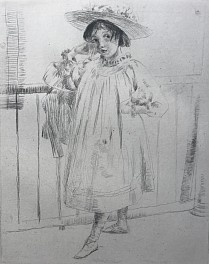BIOGRAPHY

JULIAN ALDEN WEIR
(1852-1919)
Julian Alden Weir was born at West Point, New York, the son of Robert Weir, the longtime drawing master at the military academy. The elder Weir taught his son and also had been Whistler's first teacher. Alden later studied at the National Academy of Design in New York and in Paris worked at the École des Beaux-Arts with Jean-Léon Gérôme. From the outset he was set on a course of academic conservatism. While in France he was close to the plein air genre painter Jules Bastien-Lepage, who was often regarded as being beyond the prevailing academicism. Weir's initial response to the emergent impressionism was one of disbelief. "I never in my life saw more horrible things. They do not observe drawing nor form but give you an impression of what they call nature. It was worse than the Chamber of Horrors," he wrote.
Gradually, however, he was brought around, mainly through the influence of his friends John Twachtman and Theodore Robinson. Together they explored the techniques of Japanese prints, carefully assessing the aesthetic function of flat patterning, cropping asymmetry, oblique angles, muted tonalities, and high horizons.
Weir had purchased a large farm property in Branchville, Connecticut, and like Twachtman employed its topographical resources for his landscape studies.
In 1897, with Twachtman and Hassam, he formed the group of Ten American Painters and exhibited with them for two decades. He was also a close friend and admirer of that solitary genius Albert Pinkham Ryder, caring for him in his illness and attending to the details of his hospitalization and funeral.
As Weir slowly moved toward impressionism, he painted attractive if somewhat idealized pictures of the factories at nearby Willimantic and, perhaps most dramatically, the Red Bridge that spanned the Connecticut River. As art historian William Gerdts writes, "the high horizon, the assertive geometry of the composition and especially its dominant diagonals suggest its derivation from Japanese art!" In the last decade of his life, although he had been an avid proponent of modernism, his own work came full circle, returning to a stodgy academicism.
Emery Battis Artist Biographies for the exhibition American Impressionism: Treasures from the Smithsonian American Art Museum (Washington, D.C.: Smithsonian American Art Museum, 2000)
Julian Alden Weir grew up in an artistic home on the campus of West Point Military Academy, where his father taught art. Weir recalled a magical childhood in a house crammed with paintings and rooms filled with pots of paint, mannequins, plaster casts, and other "familiar old relics." (Cummings, "Home is the Starting Place: J. Alden Weir and the Spirit of Place," in J. Alden Weir: A Place of His Own, 1991) After studying at the National Academy of Design and in Paris, Weir returned to the United States in a position to succeed in the New York art world. And it didn't hurt that he had an appealing personality and good looks. He was a celebrity among his peers, and one collector described him as a "lovable, sincere, and sympathetic companion." Weir and his wife, Anna, loved nature and spent a good deal of time away from New York in their farmhouse in Branchville, Connecticut. (Cikovsky, "J. Alden Weir & Impressionism," in A Connecticut Place: Weir Farm, An American Painter's Rural Retreat, 2000)
